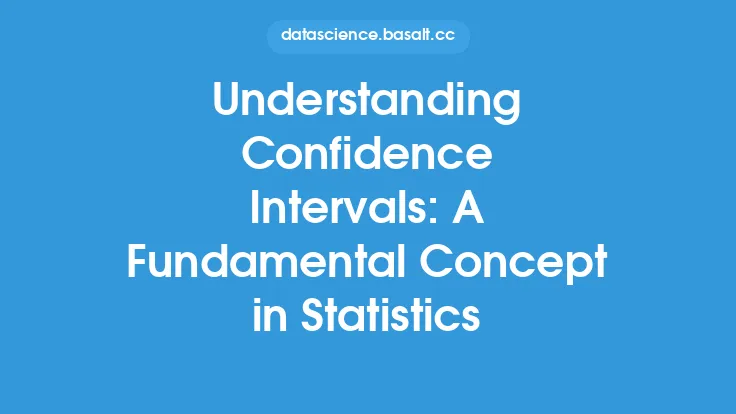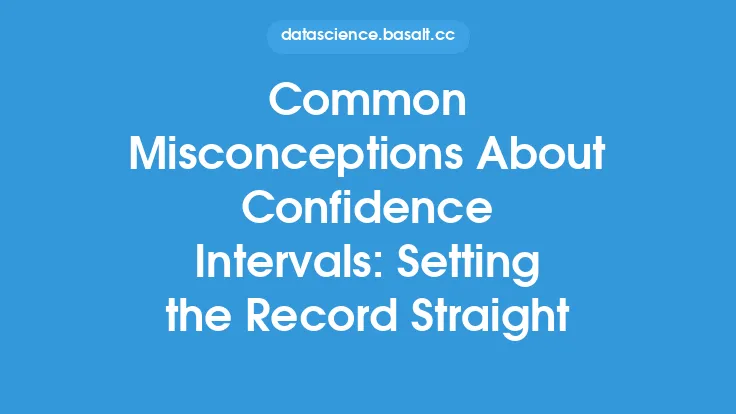In the realm of statistical analysis, confidence intervals and margin of error are two closely related concepts that play a crucial role in estimating population parameters. A confidence interval is a range of values within which a population parameter is likely to lie, while the margin of error is the maximum amount of error that can occur in an estimate due to sampling variability. Understanding the relationship between these two concepts is essential for making informed decisions based on statistical data.
Introduction to Confidence Intervals
A confidence interval is a statistical tool used to estimate a population parameter, such as the mean or proportion, based on a sample of data. It provides a range of values within which the true population parameter is likely to lie, along with a level of confidence that the interval contains the true parameter. The width of the confidence interval is determined by the sample size, the level of confidence, and the variability of the data. A wider confidence interval indicates more uncertainty in the estimate, while a narrower interval indicates more precision.
Understanding Margin of Error
The margin of error, also known as the error margin or maximum margin of error, is a measure of the maximum amount of error that can occur in an estimate due to sampling variability. It is typically denoted by the symbol E and is calculated as half the width of the confidence interval. The margin of error is a critical component of confidence intervals, as it provides a measure of the uncertainty associated with the estimate. A smaller margin of error indicates more precision in the estimate, while a larger margin of error indicates more uncertainty.
Relationship Between Confidence Intervals and Margin of Error
The relationship between confidence intervals and margin of error is straightforward: the margin of error is directly related to the width of the confidence interval. As the sample size increases, the width of the confidence interval decreases, resulting in a smaller margin of error. Conversely, as the sample size decreases, the width of the confidence interval increases, resulting in a larger margin of error. This relationship is based on the central limit theorem, which states that the distribution of sample means will be approximately normal, with a standard deviation that decreases as the sample size increases.
Factors Affecting the Relationship
Several factors can affect the relationship between confidence intervals and margin of error, including the level of confidence, sample size, and variability of the data. The level of confidence, typically denoted by the symbol α, determines the width of the confidence interval. A higher level of confidence, such as 99%, will result in a wider confidence interval and a larger margin of error, while a lower level of confidence, such as 90%, will result in a narrower confidence interval and a smaller margin of error. The sample size also plays a critical role, as a larger sample size will result in a narrower confidence interval and a smaller margin of error. Finally, the variability of the data, measured by the standard deviation, can also impact the width of the confidence interval and the margin of error.
Calculating Margin of Error
The margin of error can be calculated using the following formula: E = (Z x σ) / √n, where E is the margin of error, Z is the Z-score corresponding to the desired level of confidence, σ is the standard deviation of the population, and n is the sample size. For example, suppose we want to calculate the margin of error for a 95% confidence interval, with a sample size of 100 and a standard deviation of 10. Using a Z-score of 1.96, the margin of error would be E = (1.96 x 10) / √100 = 1.96.
Interpreting Results
When interpreting the results of a confidence interval, it is essential to consider the margin of error. A small margin of error indicates that the estimate is precise, while a large margin of error indicates that the estimate is less precise. For example, suppose we estimate the mean height of a population to be 175 cm, with a 95% confidence interval of 170-180 cm and a margin of error of 5 cm. This means that we are 95% confident that the true mean height lies between 170-180 cm, and the maximum amount of error in our estimate is 5 cm.
Conclusion
In conclusion, the relationship between confidence intervals and margin of error is a critical concept in statistical analysis. Understanding this relationship is essential for making informed decisions based on statistical data. By considering the factors that affect the relationship, such as level of confidence, sample size, and variability of the data, researchers and data analysts can accurately interpret the results of confidence intervals and make informed decisions. Additionally, calculating the margin of error provides a measure of the uncertainty associated with an estimate, allowing for more precise decision-making. By applying these concepts, researchers and data analysts can increase the accuracy and reliability of their results, ultimately leading to better decision-making and more effective solutions.





